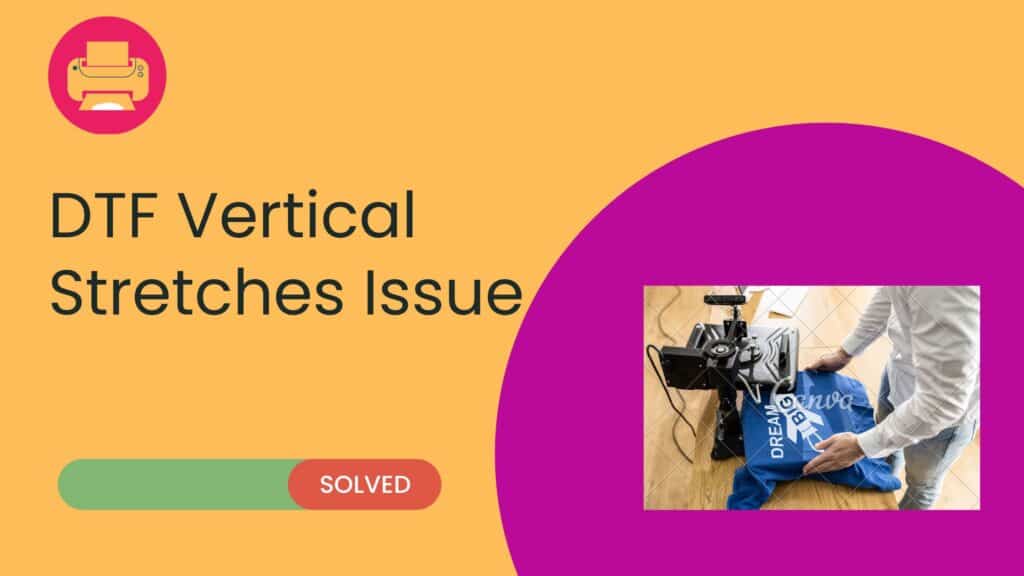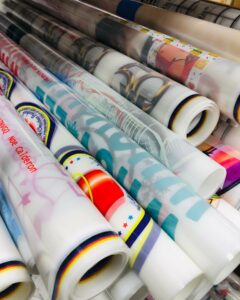Are your DTF prints lacking in quality? Consider the following scenari6o: you have the know-how, the motivation, and the tools you need for DTF printing, but a puzzling issue remains – vertical stretching. Many people have had trouble solving this problem.
However, there is no reason for worry since we will explore the core of the problem in this tutorial and provide you with the best possible resolution. Prepare to eliminate DTF prints coming out with a vertical stretch and improve your DTF prints.

Understanding the Problem
I’ve had a lot of experience with DTF printing, so I know how frustrating vertical lines, or what we call the “vertical line fault,” can be. Imagine yourself turning on your reliable DTF shirt printer, excited to see your design come to life.
But instead of the perfect work of art you had in mind, those pesky vertical lines are there. It can appear in numerous ways and is similar to a bug on your creative canvas. Sometimes, it’s those annoying flashing lines in the center of your print that resemble a test strip. Other times, it’s a disorderly collection of sloppy lines thrown together to produce a disorganized print.
Now, you might be wondering, “What’s causing this vertical line fault, and how can I remedy it?” Don’t worry, we’re going to solve the enigma and provide you with the information and answers you need to permanently remove these vexing lines from your DTF prints.
Fixing Vertical Stretches in DTF Prints
Encoder Sensor Height Adjustment:
Checking the height of the encoder sensor from the encoder strip is the first step in getting rid of those annoying vertical lines. The ideal distance between the top edge of the encoder strip and the sensor is between 1mm and 1.5mm.
This exact calibration minimizes the possibility of those annoying lines appearing by ensuring that your DTF printer can receive and interpret the data from the encoder strip precisely.
Precision Cleaning with Medical Cotton:
Sometimes, a buildup of grit or detritus on the encoder strip itself is responsible for vertical lines. In order to address this, carefully wipe the inside and outside of the encoder strip in the regions where the lines tend to emerge using medical cotton soaked in pure water.
This meticulous cleaning process ensures that the strip remains free from obstructions, guaranteeing smooth and clean prints.
Reconnect Printhead Data Cable and More:
If none of the earlier fixes have helped, it’s time to investigate your printer’s connections further. Reconnect the carriage board, main board, and printhead data cables first.
This step can help get rid of any possible contact problems between the parts of your DTF printer, fixing the vertical line fault.
Replacement of Main Board or Trolley Board:
If all else fails and those vertical lines persist, drastic measures could be necessary. Think about changing your DTF printer’s trolley board or main board. These boards are essential to the printer’s operation, and replacing them might often address complicated problems that defy more straightforward fixes.
RIP Software Check
Make sure your RIP (Raster Image Processor) software is compatible with and set up correctly for your DTF printer. When there are problems with vertical lines or print artifacts, the RIP software settings may play a role.
If you are utilizing the Cadlink RIP and have not had any problems, it is likely that the issue is unrelated to the RIP. Check the settings and compatibility of any other RIP software you use with your printer model. Adjusting RIP settings or updating or reinstalling can resolve the problem.
Permanently Stop DTF Vertical Stretches
Vertical stretching in DTF printing can be a real headache, but the good news is that with some proactive measures, you can minimize the chances of it happening. My experience as a DTF specialist has shown me that prevention is ideal. Here’s how to avoid those annoying vertical stretches:
Maintain Consistent Print Environment:
Make sure that the humidity and temperature in your printing environment stay stable. Stretching problems might result from sudden variations that influence the substrate and film.
Quality Films and Substrates:

Invest in DTF substrates and films of superior quality. Poor materials can trigger unforeseen stretching issues. For solid outcomes, go with well-known brands.
Proper Film Handling:
Take caution while handling DTF movies. When loading or unloading, try to avoid applying too much pressure or tugging. Maintain optimum alignment and tension on the film roll.
Regular Maintenance Routine:
Create a schedule for regular printer maintenance. Keep the encoder strip, printhead, and other important parts clean on a regular basis to avoid dust or other debris buildup that might result in print flaws.
Calibration and Testing:
DTF printers should be calibrated regularly to maintain optimum performance. Conduct test prints to catch any potential issues early on and make necessary adjustments.
Monitor Ink Levels:
Monitor your ink levels and swap out cartridges as necessary. Stretching in prints can occur as a consequence of low or uneven ink dispersion.
Expert Guidance
Don’t be afraid to ask experienced DTF printing professionals for advice when in doubt or when dealing with chronic issues. They could offer insightful advice and tailored solutions for your particular situation.
Keep up with new developments and advancements in DTF printing technology. Many manufacturers give firmware or software upgrades to fix stretching concerns.
Conclusion
To sum up, overcoming the vertical stretching problem in DTF printing requires a combination of technical expertise, rigorous debugging, and proactive avoidance. You can address this problem with these insights and solutions.
Maintain your proficiency, keep up with market developments, and adopt a commitment to perfection in every print. Those annoying vertical stretches can be reduced to a distant memory with perseverance and a dedication to quality, enabling your DTF prints to shine wonderfully.
FAQs
DTF prints may have uneven or extended patterns, lines, or distortions due to vertical stretching. The quality of your printed designs could decline as a result of these irregularities.
Using inferior or unsuitable DTF substrates and films could worsen vertical stretching issues. Make sure the materials are compatible with your printer and stick with trusted brands.
Yes, regular calibration is essential to maintaining your DTF printer’s peak performance. Ensuring precise alignment and settings prevents printing difficulties like stretching.
You should include cleaning the encoder strip in your normal maintenance. A monthly cleaning plan is a reasonable place to start, depending on use and environmental considerations. Adapt as necessary.
Look to see if your DTF printer’s manufacturer has made any software changes available. Additionally, make sure your RIP software is set up properly. Update firmware and software to avoid stretching.
Heat press settings primarily effect adhesion, but if they are improperly adjusted, they can additionally indirectly cause stretching. Make sure the settings on your heat press correspond to the ones suggested for your DTF prints.
Consult a DTF printing expert if you’ve exhausted all troubleshooting steps and the issue persists, or if you’re uncertain about the underlying cause. They can offer specialized guidance for your specific setup.
In addition to what has been discussed, it is essential to maintain consistent environmental conditions and use high-quality, appropriately handled materials. Additionally, to reduce the possibility of vertical stretching, always adhere to recommended standards for handling and maintaining printers.

Ashley Wang is a skilled sales manager with knowledge in DTF printing. She presently works for ShenLan Digital, a reputable DTF printer maker. Ashley is the best person to offer advice on selecting the most suitable DTF printer because she has tested a lot of them. She launched DTFPrinterSchool to educate individuals and organizations about DTF printing technology, providing her expertise and observations on the most recent advancements in the sector. Ashley is an invaluable resource for businesses and individuals wishing to invest in DTF printing technology because of her expertise and experience in the industry.
